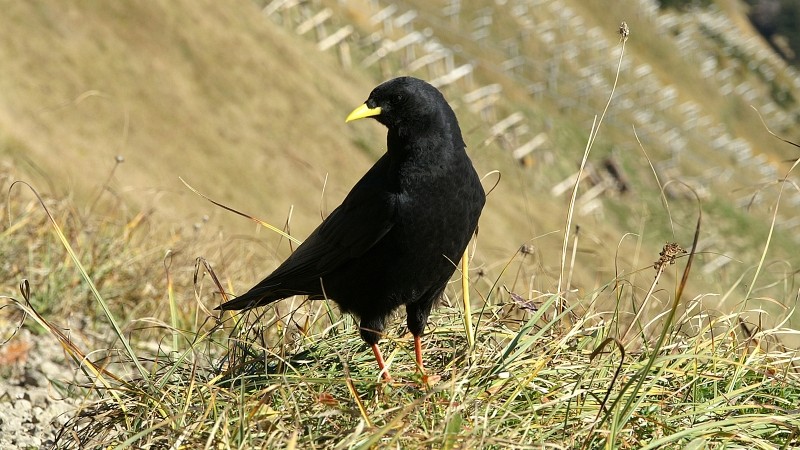Yellow-billed Chough
A species of Chough Scientific name : Pyrrhocorax graculus Genus : Chough
Yellow-billed Chough, A species of Chough
Botanical name: Pyrrhocorax graculus
Genus: Chough
Content
Description People often ask General Info
 Photo By Ken Billington , used under CC-BY-SA-3.0 /Cropped and compressed from original
Photo By Ken Billington , used under CC-BY-SA-3.0 /Cropped and compressed from original Description
The adult of the nominate subspecies of the Alpine chough has glossy black plumage, a short yellow bill, dark brown irises, and red legs. It is slightly smaller than red-billed chough, at 37–39 centimetres (15–15 inches) length with a 12–14 cm (4.7–5.5 in) tail and a 75–85 cm (30–33 in) wingspan, but has a proportionally longer tail and shorter wings than its relative. It has a similar buoyant and easy flight. The sexes are identical in appearance although the male averages slightly larger than the female. The juvenile is duller than the adult with a dull yellow bill and brownish legs. The Alpine chough is unlikely to be confused with any other species; although the jackdaw and red-billed chough share its range, the jackdaw is smaller and has unglossed grey plumage, and the red-billed chough has a long red bill. The subspecies P. g. digitatus averages slightly larger than the nominate form, weighing 191–244 g (6.7–8.6 oz) against 188–252 g (6.6–8.9 oz) for P. g. graculus, and it has stronger feet. This is in accordance with Bergmann's rule, which predicts that the largest birds should be found higher elevations or in colder and more arid regions. The extremities of the body, the bill and tarsus, were longer in warmer areas, in line with Allen's rule. Temperature seemed to be the most important cause of body variation in the Alpine chough. The flight of the Alpine chough is swift and acrobatic with loose deep wing beats. Its high manoeuvrability is accomplished by fanning the tail, folding its wings, and soaring in the updraughts at cliff faces. Even in flight, it can be distinguished from the red-billed chough by its less rectangular wings, and longer, less square-ended tail. The rippling preep and whistled sweeeooo calls of the Alpine chough are quite different from the more typically crow-like chee-ow vocalisations of the jackdaw and the red-billed chough. It also has a rolling churr alarm call, and a variety of quiet warbles and squeaks given by resting or feeding birds. In a study of chough calls throughout the Palearctic region it was found that call frequencies in the Alpine chough showed an inverse relationship between body size and frequency, being higher-pitched in smaller-bodied populations. 
Size
37 - 39 cm
Colors
Black
Life Expectancy
5-10 years
Nest Placement
Cliff
Feeding Habits
Yellow-billed Chough consumes invertebrates, fruits, and plant material. It forages in groups, varying in size with seasons, and often supplements its diet at tourist sites. Yellow-billed Chough exhibits food storing behavior and changes foraging locations based on food availability and season.
Habitat
Yellow-billed Chough's habitat comprises high-altitude meadows, rocky crags, and scree slopes above the tree line in mountainous regions. They adapt to extreme altitudes, nesting up to 6,500 meters and foraging in open areas. Their range includes European to North African mountains and the Himalayas, inhabiting elevations from 600 meters in the Balkans to 5,000 meters in the Himalayas.
Dite type
Omnivorous
People often ask
General Info
Feeding Habits
Bird food type
Distribution Area
The Alpine Chough breeds in mountains from Spain eastwards through southern Europe and the Alps across Central Asia and the Himalayas to western China. There are also populations in Morocco, Corsica and Crete. It is a non-migratory resident throughout its range, although Moroccan birds have established a small colony near Málaga in southern Spain, and wanderers have reached Czechoslovakia, Gibraltar, Hungary and Cyprus. This is a high-altitude species normally breeding between 1,260–2,880 metres (4,130–9,450 ft) in Europe, 2,880–3,900 m (9,450–12,800 ft) in Morocco, and 3,500–5,000 m (11,500–16,400 ft) in the Himalayas. It has nested at 6,500 m (21,300 ft), higher than any other bird species, even surpassing the red-billed chough which has a diet less well adapted to the highest altitudes. It has been observed following mountaineers ascending Mount Everest at an altitude of 8,200 m (26,900 ft). It usually nests in cavities and fissures on inaccessible rock faces, although locally it will use holes between rocks in fields, and forages in open habitats such as alpine meadows and scree slopes to the tree line or lower, and in winter will often congregate around human settlements, ski resorts, hotels and other tourist facilities. Its penchant for waiting by hotel windows for food is popular with tourists, but less so with hotel owners. 
Scientific Classification
Phylum
Chordates Class
Birds Order
Perching birds Family
Crows and jays Genus
Chough Species
Yellow-billed Chough